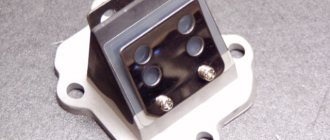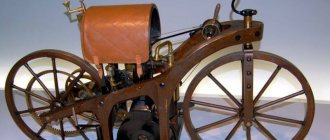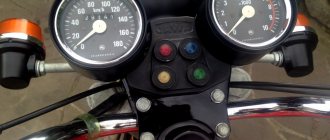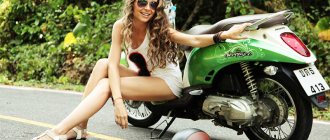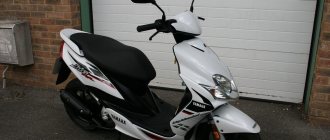Although a scooter and a motorcycle appear to be very similar vehicles at first glance, the differences between them are vast and obviously affect how the vehicle is handled and used. In this article we answer the age-old question of buyers - what to choose? Scooter, scooter or motorcycle? What is worth buying and what to consider when choosing a scooter or motorcycle.
Differences between a motorcycle and a scooter. What is the difference between a scooter and a motorcycle.
Are you curious about the differences between a motorcycle and a scooter? The most important difference, of course, is their size and power. The scooter is usually equipped with a very small and not very powerful motor. This limits its power and acceleration, but it also means it doesn't require a permit to drive and is extremely easy and uncomplicated to drive. On the other hand, the motorcycle is much larger, more powerful and, of course, faster. In addition, it is of course much more expensive.
Technical characteristics, design features
Scooters are usually smaller in size and weight. Compare: the weight of a motorbike reaches 200 kg, and the Fortune YHXTE scooter with dimensions 1665x610x1050 weighs 70 kg.
Scooter wheels are installed in sizes 8–15 inches, significantly smaller than those of bikes.
A motorcycle's engine is located between the wheels, supplying power through a driveshaft or chain to the rear wheel. In a scooter, the engine is located close to the rear wheel, transmitting power directly, without additional lines. In addition, the engine is placed lower, adding stability to the vehicle.
There is a difference in fuel consumption: a scooter consumes 2 l/100 km (Fortune YH50QT-16), a bike requires 10 liters for the same distance.
The motorcycle gears are controlled by pressing the left lever with your hand and pressing the pedal with your left foot. The scooter has an automatic transmission, controlled by a lever on the right handle.
The bike is braked through the right foot pedal for the rear wheel, and using a lever on the right handle for the front wheel. The scooter's brakes are controlled by levers located on the handlebars - for both wheels when pressed with both hands.
The seat on the scooter is comfortable for the driver, straight, the legs are placed on the platform in front of you, under the protection of the body from dirt and water. The motorcyclist places his legs on the sides of the seat, moving them back, leaning his body forward.
The components and parts of the scooter are hidden by plastic casing.
The license plate is not installed on the scooter, the equipment is not registered with the traffic police when the engine capacity is below 50 cubic meters.
The scooters are equipped with a spacious trunk located under the seat, which is locked.
What should you consider when buying a motorcycle or scooter?
Are you wondering what to consider when buying a motorcycle or scooter?
The most important thing to decide when choosing one is where it will be used. If it is to be a vehicle only for short city distances, it is worth choosing a scooter. However, if this vehicle will also be used for more challenging trips, it is definitely better to choose a more powerful and comfortable motorcycle in this regard.
Moving around the city. What will be better? A scooter or motorcycle when you are just moving around the city.
Life in the city, although full of various advantages and conveniences, is also burdened by the need to overcome constant traffic jams on a daily basis. It's no surprise that many people try to escape them by choosing vehicles that are easy to navigate in a crowded city. What type of car should I choose?
Scooter or motorcycle? What is better to buy for driving around the city?
If you are asking yourself what is the best thing to buy for driving around the city, you know for sure that the city is a special environment for movement. The vehicle must perform well in the conditions prevailing in cities during rush hour.
It is for these reasons that a scooter seems to be the best vehicle for a smooth ride around the city. You can start the engine immediately after purchasing it and enjoy unlimited mobility around the city.
Frequent trips on long trips. Which is better - a scooter or a motorcycle when you have to travel often?
Many people need a car for long trips. Which vehicle - a scooter or a motorcycle - is better to choose in order to be able to go on such trips?
Although the price and fuel consumption level of the scooter speak in its favor, it is better to take a motorcycle with you on long trips.
Why? Firstly, because it will be much more convenient. The position even on the sportiest motorcycle is much more comfortable than on a scooter. Secondly, even despite low fuel consumption, the scooter will cover a given route much slower, and therefore more expensive. Also, do not forget that the low speed of a scooter on a road outside the city will be simply dangerous.
Post Views: 1,821
Scooter club
I wanted to write a comment on this topic, but it turned out to be too much, so I decided to write it into a separate post. The following comments were made there: “I wonder what the essence of the very powerful Maxiks is, it seems like in the city they are useless except for a large trunk.” “The question is how they will steer...” “Why are they all being careful? Let’s get liter scooters already!”
Due to the fact that I just returned from Greece, where I rented a Yamaha X-Max 250 scooter, I would like to share some thoughts on this matter. If anyone is interested, please click below...
First of all, I don’t make any special distinction between scooters and motorcycles - I consider both to be “two-wheeled”, they’re just different classes of motor vehicles, like a jeep and a roadster, for example. I myself once started with scooters, but I switched to motorcycles a long time ago and have almost forgotten what it’s like to ride a scooter. However, lately I have periodically caught myself thinking that maybe I should try, so to speak, to return to my roots. And so, having ridden a scooter for about 500 km on highways, cities and mountain roads, I had the following thoughts about this class of motorcycle equipment:
Pros: It's mega convenient! The main convenience lies in a) luggage containers, where you can put a lot of things, including equipment (your own and for the passenger) and a bunch of other junk. b) In the absence of a clutch and gearbox (it is in traffic jams and maneuvering at low speed that this is convenient). c) Low-slung and easy to get on and off the scooter. d) It is also more convenient for a passenger than a motorcycle. The seating position is relaxed, there is no jerking when shifting, etc. e) Another plus is wind protection. And if the scooter is also narrow, then it can navigate traffic jams no worse than a motorcycle. e) I almost forgot - the rear brake is on the steering wheel! Yes! It's comfortable! 250cc allows you to maintain a constant speed of around 100 and not feel very disadvantaged on the highway, but overtaking is difficult, so scooters of 400, 500 and more cubic meters are good and you can go somewhere far away with them, with a passenger and luggage. But with more power there may be problems, I’ll tell you about them below because that’s where the advantages end and begin...
Cons: In my opinion, scooters are not suitable for high-speed and aggressive driving and it’s not about power (65 hp is already decent). It’s a) a matter of sitting feet first (putting your feet under you like a motorcycle does not help much and is even more of a hindrance, and when braking you have to move them back, otherwise you’ll have to lean against the handlebars, and that’s wrong). b) In the absence of a tank between the legs. When “stuck” in corners and on bumps, the scooter feels and is poorly controlled. As the owner of a sportbike, it was difficult for me to confidently turn on serpentine roads without holding the tank with my knee. c) In the variator. In that very convenient variator at low speeds and in traffic jams. The problem is that it does not allow precise control of traction and its reactions are somewhat rubbery, which can be convenient for leisurely movement, but can come out sideways during aggressive riding. Therefore, manufacturers do not strive to make very powerful scooters because all this power will be difficult to control. Well, plus the V-belt variators themselves cannot handle heavy loads yet.
I concluded for myself that for now I will still remain a devotee of motorcycles. Their advantages outweigh them for me. The only thing I really miss is the trunk! After all, there is a Honda NC700 with a false trunk! An excellent solution, although there is only room for a helmet. It’s frustrating that this is practically the only such beast and the beast, unfortunately, is very low-cost. Is it really impossible to somehow get rid of it and make room in other models? Will be comfortable! I hope that the engineers will be able to somehow solve this issue, but for now it looks like we’ll have to install a case.
Distinctive features
But the classes have many more distinctive features. In addition to the fact that in terms of speed indicators they are at opposite poles, a number of other parameters are distinguished.
Yamaha YZ250 motocross motorcycle.
For this purpose, classes are considered separately. And you can start with a cross-country one.
What is characteristic of a motocross motorcycle?
A typical representative of the junior cross-country type is the HONDA CRF 125.
Cross-country motorcycles are designed for racing and moving around the city on one is not very convenient. A racing track is like a stadium. There are stands for spectators, a central field (often this is where team garages and all kinds of official equipment are moved) and running tracks, or in the case of motorcycles, driving tracks. Only, unlike the stadium, the latter are not paved.
In order to participate in races, any motocross motorcycle must meet the requirements of racing, which bear little resemblance to traffic rules.
The motocross motorcycle has:
- full-size spoked wheels;
- tires that are similar to those used in enduro, but the requirements for cross-country tires are an order of magnitude higher;
- large working stroke of the pendulum and fork (200-300 mm).
Cross-country motorcycles are characterized by an inverted fork. There, less dirt gets into the rod.
The latter is most often of an inverted type, for better handling.
In addition, the characteristic features of such bikes are the reduced size of the steering wheel and a loud exhaust due to a lightweight and sometimes completely absent muffler.
Now, by the way, cross-country racing on pit bikes is gaining popularity.
But the main thing is that although such a bike does not require a license, operating it requires special skills.
What is inherent in a pit bike?
Unlike a cross bike (this is how “cross motorcycle” is abbreviated), you can ride a pit bike in the park, at the dacha, or even on the playground (naturally for a child).
Kayo classic 125 pit bike.
Pitbike REGULMOTO 125
Pitbike Irbis TTR 125 in standard coloring.
This “transport” has:
- compactness and light weight;
- ease of control;
- low cost upon purchase;
- easy and inexpensive maintenance.
But this also includes small wheels and safety. Children's cars are also distinguished by a greater possibility of customization to suit the level of vehicle ownership and understanding of control features.
Differences according to law
According to traffic regulations, mopeds are two- or three-wheeled vehicles whose engine capacity does not exceed 50 cm3, and whose maximum speed is structurally limited to 50 km/h. Two-wheeled vehicles with a volume of more than 50 cm3 or capable of reaching high speeds are considered motorcycles, even if they do not differ from a moped in design.
Russian legislation does not require mopeds to be entered into the state register or have license plates. Also, moped owners are not burdened with the obligation to undergo regular technical inspections and compulsory insurance of their vehicle. These features, as well as the low cost of mopeds, have made them highly popular among young people as a vehicle ideally suited for driving in an urban environment.
Sportbike
Sport bike
Sports motorcycles require a lightweight design coupled with a high-performance engine and an aerodynamic body kit. But the driver is in a half-bent position, and these are far from the most comfortable and practical models. They are more suitable for experienced motorcyclists who are good at handling vehicles in any driving conditions. Engine volumes range from 250 cc. see also real exoticism, which only professionals can ride. The cost of purchasing such a bike is from 150,000 rubles.
Advantages and disadvantages of each type
Now let's take a separate look at the positive and negative sides of each type of transport.
Scooter, its advantages:
- the presence of an automatic transmission does not force the driver to perform additional actions when driving;
- the absence of a clutch system makes it convenient to move in traffic jams;
- there is no need to throw your leg across the entire scooter to the other side;
- good level of comfort regardless of the owner’s height;
- comfortable protection of feet from tree branches, grass and water;
- the presence of a large front shield makes travel in cool weather more comfortable;
- compact design;
- increased safety due to low top speed;
- the small cubic capacity of the power unit allows for significant savings on fuel;
- no need to undergo technical maintenance or take out insurance;
- there is our own platform for transporting goods;
- the ability to ride in any clothing;
- comfortable seat for the passenger;
- spacious luggage compartment.
The most valuable advantage of the scooter is that it is suitable for riding scooters with an engine capacity of up to 50 cc. no driver's license required!
Now let's talk about the disadvantages:
- small wheel diameter increases sensitivity to irregularities;
- difficult to drive off-road;
- problematic maintenance and restoration due to the need to disassemble a large number of parts;
- low level of road stability;
- the driver is not able to regulate the vehicle using his legs;
- short-travel suspension worsens handling;
- limited maneuverability, speed and lane changes.
The history of motor vehicles
The first production of motorcycles began in 1901. At that time, the Werner brothers thought about whether it was possible to install a motor on a two-wheeled vehicle. Despite the fact that even before them, engineers tried to come up with something similar, it was they who patented their own development. The Werner motorcycle turned out to be a heavy, clumsy machine, which almost immediately became popular among postmen and couriers. A four-stroke power unit running on gasoline was installed between the wheels. The power was only 0.75 horsepower. But this was quite enough to develop a decent (for those times) speed of 35 kilometers per hour. After several years of modernization, they began to use an electric ignition system. In the first year after Werner motorcycles went on sale, three and a half thousand copies were sold. It was from this time that the long history of the motorcycle industry began.
At the beginning of the twentieth century, the first modification of motorcycles appeared, called “motor scooter”. Piaggio decided to develop its own version of a two-wheeler, characterized by its compact size. The equipment was originally intended to simplify movement around the internal territory of large production/warehouse enterprises. Thus, workers did not have to spend several additional hours walking between racks. This type of transport was not initially intended to travel on public roads, so the landing here was different. The design had small diameter wheels and a power unit with a low power level. Scooters began to actively spread among urban residents, especially those who lived in a metropolis.



